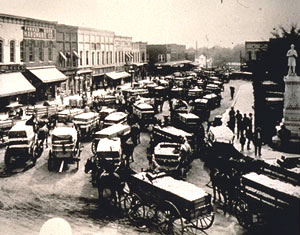
Dyer County
The Tennessee General Assembly established Dyer County in 1823 and named it in honor of Colonel Robert H. Dyer. John McIver and Joel H. Dyer donated sixty acres for the new county seat, named Dyersburg, at a central location within the county known as McIver's Bluff. In 1825 Joel Dyer surveyed the town site into eighty-six lots; the first courthouse was built on the square in 1827. The present Classical Revival-style courthouse, designed by Asa Biggs in 1911, centers a downtown historic district listed in the National Register of Historic Places. The county’s population in 2000 was 37,279.
Fertile soil and plentiful stands of timber made Dyer County rich farming country. The early profitable crops of corn and tobacco were replaced in the post-Civil War era by a reliance on cotton, and the timber industry expanded. Situated at the head of steamboat navigation on the Forked Deer River, Dyersburg grew as a river town, especially once the Grey Eagle made the first successful steamboat trip in 1836. The county was spared the worst of the Civil War, as no major battles or other activity occurred within its borders. Dyersburg resident Otho F. Strahl raised a local Confederate infantry company in 1861 and then steadily advanced to the rank of brigadier general in the Army of Tennessee. On November 30, 1864, Strahl was killed at the battle of Franklin.
The county's first industrial boom dates to 1879, when the steamboat Alf Stevens shipped timber from A. M. Stevens Lumber Company of Dyersburg to St. Louis markets. The Stevens company established a large sawmill in 1880 and opened a planing mill in 1885. The Bank of Dyersburg opened in 1880, while another timber industry, Nichols & Co. Wooden Bowl Factory, began operations in 1881. The arrival of the Newport News and Mississippi Valley Railroad in 1884 further expanded market possibilities; a branch line, the Dyersburg Northern, soon linked the county seat to Tiptonville. The new railroad links encouraged the creation of new industries and businesses. In 1884, for example, investors established the Dyersburg Oil Company, a cottonseed factory. This company remained locally important through the twentieth century.
In 1904 and 1907 Dyersburg hosted two huge revivals conducted by evangelist George C. Gates. The 1907 revival alone converted seven hundred people. The revivals preceded Dyersburg's greatest boom as it emerged as a regional railroad hub. Between 1909 and 1914 Dyersburg became the junction point for three different lines, led by the Illinois Central Railroad. The Illinois Central expanded its facilities throughout the county, building in 1920 a new combination depot at the town of Newbern, a major cotton and livestock shipping point. Listed in the National Register, this depot survives and is one of only two Amtrak passenger stops in Tennessee. Newbern is the county's second largest incorporated city. Smaller villages include Trimble, Fowkles, Finley, Bogota, and Heloise, the county's sole Mississippi River village.
By the 1920s the rich timber resources of Dyer County were gone; cotton was the county's leading resource. African Americans participated actively in the Rosenwald school-building program, sponsoring and constructing four schools across the county, while white officials put up most of the money for a modern sixteen-room industrial training school for blacks. Known as Bruce High School, it remained a segregated facility until it closed in 1966. In 1929 Dyersburg Cotton Products built a modern plant complete with company housing on the outskirts of Dyersburg. The town's largest industrial concern, the plant consumed about six million pounds of cotton each year from local farmers. The great Mississippi River floods of 1927 and 1937 devastated western Dyer County, especially lands between the Obion and Mississippi Rivers.
During World War II the Halls Air Base, located at the border of Lauderdale County and Dyer County, created many civilian jobs as it trained hundreds of B-17 bomber pilots. An emergency landing strip was also built in Dyersburg. After the war agriculture in Dyer County began to shift from cotton into new crops. By the mid-1980s soybeans composed the largest crop by far, followed by wheat, milo, corn, and cotton. Industry continued to expand and the county became a regional medical, educational, retail and distribution center. The establishment of Dyersburg State Community College in 1969 enhanced educational and cultural opportunities in the county. In the last two decades, two major projects have modernized the county's transportation system: Interstate I-155 links Dyersburg with Missouri via the only highway bridge (1976) over the Mississippi River between Cairo, Illinois, and Memphis, and the four-lane expansion of U.S. 412 connects Dyersburg to I-40 at Jackson.



